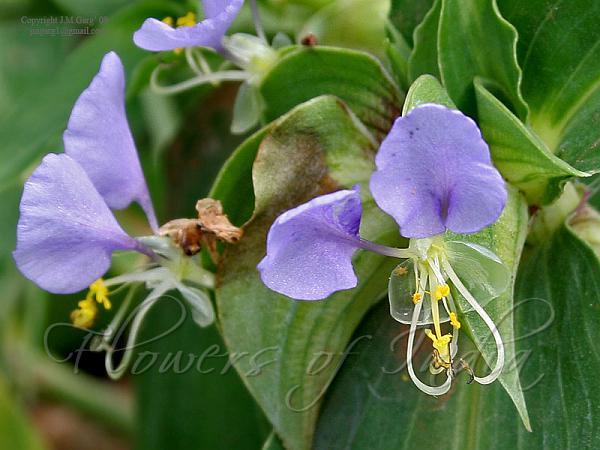|
| Spotted Dayflower |
|

|

| File size | 117566 |
| Original date | 8/2/09 10:19 AM |
| Resolution | 800 x 600 |
| Flash | Flash did not fire, auto |
| Focal length | 55.0mm |
| Exposure time | 1/125s |
| Aperture | 10.0 |
| Focus Distance | |
| Metering Mode | Multi-segment |
| Camera make | Canon |
| Camera model | Canon EOS 350D DIGITAL |
| Sensor type |
|
|
|
|
Photo: |
Botanical name: Commelina maculata Family: Commelinaceae (Dayflower family)
Synonyms: Commelina obliqua var. viscida, Commelina paludosa var. viscida
Synonyms: Commelina obliqua var. viscida, Commelina paludosa var. viscida
Spotted Dayflower is a perennial herb. Stems are rising or creeping,
branched, glabrous or sparsely hispidulous throughout or in a line. Leaf
sheaths are brown, white, or yellow ciliate at mouth, glabrous elsewhere
or hairy in a line on 1 side. Leaf blade is ovate-lanceolate or
lanceolate, 4-10 × 1.5-2.5 cm, velvety on both surfaces. Involucral bracts
are 2 or 3, forming heads at the tip of branches, stalkless or with stalks
less than 5 mm, funnel-shaped, 1.5-2 cm, hairless or sparsely
multicellular hispid. Proximal margins are joined togethere, tip is
shortly pointed. Cincinni arise with 3 or 4(or several) flowers slightly
exserted only at anthesis and included in fruit. Flower stalks are about 3
mm. Sepals are 4 mm, membranous. Petals are blue, 2 anterior ones to 1 cm,
posterior one 4 mm. Capsule globose, trigonous, ca. 4 mm, 3-valved, or
2-valved by abortion of 1 ovule. Seeds 1 per valve, gray-black, ellipsoid,
ca. 3 mm, slightly flattened, subsmooth. Spotted Dayflower is found in
humid forest margins, grasslands, roadsides, ditches, near sea level to
2900 m. Flowering: June-August.
| Identification credit: Satish Pardeshi | Photographed in Pocharam, Distt. Medak, Andhra Pradesh. |
• Is this flower misidentified? If yes,